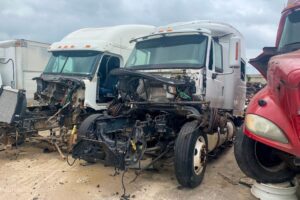Head-on truck collisions account for only a small percentage of motor vehicle accidents yearly. Compared with other accidents, the chances of getting into a head-on collision with a large commercial truck are quite low. In contrast, rear-end accidents involving big rigs account for about 25 percent of all truck accidents each year.
However, head-on collisions are generally the most severe and most likely to lead to catastrophic injuries and fatalities. Frequently, those who survive head-on collisions are left unable to work for lengthy amounts of time while recovering from their severe injuries.
They also face incredibly high medical expenses. Suppose you or someone you love suffered injuries in this type of accident. In that case, you need the help of a skilled Denver truck accident attorney to help you recover the compensation you are entitled to receive.
Causes of Head-on Collisions
Head-on collisions occur when one vehicle’s front end collides with another vehicle’s front end. A head-on crash is often the result of speeding, reckless driving, or driving while under the influence of alcohol or drugs. They typically occur on two-way highways or roads where lane crossing is common. Head-on collisions, even at slow speeds, can cause extreme or fatal injuries that have long-lasting impacts. When a head-on collision occurs with a large truck, the results are even more disastrous due to their substantial size and weight.
Common causes of head-on crashes include:
- Driver fatigue: Long-haul truckers or truckers who work night shifts and long hours are at a higher risk of fatigue and reduced reflexes and are more prone to fall asleep while driving.
- Distracted driving: Drivers today face many distractions, especially truck drivers who are often alone on the road for days on end. For example, dialing, talking, or texting on cell phones, eating and drinking, attempting to use GPS devices and other technology aboard their vehicle, or talking to other passengers are all forms of truck driver distraction. Despite warnings and public education, distracted driving is still a leading cause of car accidents, including head-on collisions.
- Driver confusion: There are times when truck drivers may become confused, especially on unfamiliar roads. In their confusion, they may drive on the wrong side of the road, drive up off-ramps, or make other similar maneuvers that lead to a head-on collision.
- Driving under the influence (DUI): Intoxicated drivers cause the majority of head-on collisions, even though being intoxicated behind the wheel is illegal and a public health issue. A drunk or drugged driver’s reflexes are markedly impaired. Their ability to calculate distance and direction is much less than when they are sober. Additionally, their judgment is impaired, and their reflexes are slower.
- Speeding: Speed is always a contributing factor to the severity of head-on collisions. However, this factor is especially concerning on rural and winding roadways, as higher speeds make it difficult for large trucks to stay in their lanes. Unfortunately, it’s often too late for oncoming traffic to see the truck and avoid a collision.
- Losing control of the vehicle: A tire blowout, which big rigs are prone to, or even a vehicle malfunction, can cause a truck driver to lose control of their big rig suddenly. If the driver isn’t in control of a vehicle, anything can happen, including a head-on collision.
- Passing on an unbroken line: Passing on a two-lane rural road is only allowed when there is a broken line between the two lanes. If the line is solid, it’s illegal and unsafe to pass. If drivers forget or simply ignore this rule, the risk of a head-on collision increases.
- Medical issues: Truck drivers can have known or unknown medical issues such as heart problems, diabetes, seizures, or syncope (passing out). These issues can render them suddenly and unexpectedly unable to drive their truck properly.
- Defective traffic signals: When a traffic light is out, drivers must proceed as if the intersection were a stop sign; stop and then wait until it is safe to proceed. However, more often than not, drivers are unaware of this driving rule. Drivers might turn in front of one another, causing a head-on collision.
- Poor road conditions: The conditions of a road and other conditions nearby can make it more likely that a driver will veer into the oncoming traffic. Drivers need to watch out for faded divider lines, potholes, debris on the road, inadequate lighting, and broken guardrails that can pose a danger.
- Irresponsible driving in poor weather: Whether it is rain, fog, snow, or another weather event, the driver may be unable to see the lines on the road and oncoming traffic, leading to a head-on collision
- Collateral accidents: When multiple cars are involved in an accident, they can bounce off each other, sending one or more vehicles into oncoming traffic lanes.
Head-On Collisions Are Serious
There is no arguing that head-on collisions are among the most severe car accidents on Colorado’s roadways. Also referred to as frontal impact collisions, head-on crashes contribute to only about 3 percent of all large truck crashes annually, according to the Federal Motor Carrier Safety Administration (FMCSA). As such, many victims and their families hire experienced Denver truck accident attorneys to seek the compensation they deserve.
Two crucial factors cause these accidents to have severe results. First, since the front ends of both involved vehicles collide, drivers and front-seat passengers are the most likely to get injured or die in the accident. This risk increases even more if the impact of the accident causes the front end of the vehicle to crumple, crushing the driver and passenger. Since passenger vehicles are much smaller than big rigs, it’s usually the occupants of that vehicle that suffer the most harm.
Second, two vehicles traveling towards one another, sometimes at high speeds, results in the combined total force and speed of both. This causes a much more severe impact than if the two vehicles were traveling in the same or different directions instead of at each other.
For instance, two vehicles in a head-on collision, both traveling 30 miles per hour, will result in the same force as a single-car accident at 60 miles per hour when hitting a stationary object. Head-on crashes that occur on highways are usually the most dangerous because of the motor vehicles’ high velocity.
Since head-on collisions are so violent and sudden, drivers and passengers are both likely to sustain severe injuries. Their injuries might lead to expensive medical bills, surgeries, hospitalizations, lost income while not working during their recovery, and extreme property damage. To have the best chance to rebuild your life and move on, you will need full and fair financial compensation for your damages.
What Factors Lead to Head-On Collisions?
Even with several preventative measures in place to protect motorists against lane departures, such as signs before sharp curves in the road and median barriers between opposing lanes of traffic, head-on accidents still happen.
Several different factors can lead to head-on collisions, and most involve human error. For example, head-on collisions often happen when one vehicle crosses the centerline hitting an oncoming vehicle. They can also occur when a driver is driving in the wrong direction while traveling on the road.
Other causes of head-on collision include but aren’t limited to:
- Passing another vehicle on a street or two-lane highway
- Swerving between lanes because of construction or a stopped vehicle
- Roadway defects
- Automobile malfunctions and defects
No matter what factors influence the accident, each driver has a legal obligation to adhere to traffic rules and drive in a way that keeps others safe. When a driver is negligent and fails their obligation, a Denver truck accident attorney can help victims hold them liable for the damages that occur as a result.
Claims Against Government Entities
 Sometimes a head-on collision results from a factor that government municipalities had control over, for instance, malfunctioning traffic lights, potholes, and poor or lack of signage during construction. These cases can be quite complex with strict deadlines, requiring a Denver truck accident lawyer’s knowledge and experience.
Sometimes a head-on collision results from a factor that government municipalities had control over, for instance, malfunctioning traffic lights, potholes, and poor or lack of signage during construction. These cases can be quite complex with strict deadlines, requiring a Denver truck accident lawyer’s knowledge and experience.
If you think your head-on accident happened due to a defect in a vehicle or its parts, your claim against the manufacturers can also be burdensome. Large manufacturing companies frequently put up a fight when it comes to their liability for accidents. However, with the help of an attorney, you can ensure that you will get the best outcome possible.
Colorado Head-On Collision Injuries
Thankfully, head-on collisions aren’t a common occurrence, but when they do happen, serious injuries result. Victims may die or become disabled from their injuries or even have scarring and disfigurement from severe injuries.
With such a high degree of powerful forces during a head-on accident, both drivers and their passengers are likely to sustain traumatic brain and spinal cord injuries, possibly resulting in permanent paralysis. Additional injuries commonly associated with head-on collisions include internal injuries and bleeding, and fractured bones anywhere in the body.
The velocity and weight of the vehicles involved in a head-on crash have a considerable influence on bodily and property damage. In accidents involving trucks and other heavy vehicles entering the oncoming lane of traffic, the force of the larger vehicle colliding with a medium or small passenger automobile will typically cause catastrophic injuries to the passengers of the standard vehicle or even multiple fatalities.
You always need to consult with a well-versed Denver truck accident lawyer who has an in-depth knowledge of the physics associated with a head-on crash and can also consult with accident experts and reconstructionists as necessary. A successful truck accident claim depends on the ability to prove both the other party’s fault in the accident and your injuries.
The most common injuries resulting from a head-on collision include:
- Broken facial bones: The impact and force of the collision are often severe enough to crush the bones that structure the face. Fractures to eye sockets, chins, cheeks, and jawbones are common.
- Whiplash: The necks, shoulders, and heads of all involved can violently twist back and forth and side to side, resulting in injuries to the muscles, ligaments, and tendons.
- Back and spine injuries: Discs of the spinal cord can herniate, or the spinal cord can bruise or sever, leading to paralysis or even death due to the force of the accident.
- Lacerations, abrasions, and contusions: Secondary injuries can occur when loose objects in the vehicle or other debris such as metal, shards of broken glass, fiberglass, and pieces of plastic are airborne around the car at high speeds, causing visible injuries to the face, arms, and legs.
- Traumatic brain injury (TBI): Skulls can break upon impact with the steering wheel, windshield, or vehicle frame. A TBI can also happen when the brain slams against the skull from the force of the collision, causing concussions or more severe injuries. A broken skull can also pierce the brain, causing severe brain damage.
Winning Your Head-On Accident Case
To prove that the driver’s negligence resulted in the head-on collision and your injuries, you must have a preponderance of the evidence. This means that you must have enough evidence to show that it is more likely than not that another party was at fault for the accident.
When you hire a resourceful attorney, they will know how to shape and strengthen claims through investigation and legal strategy.
They will help you get the evidence required to win your case by:
- Locating, requesting, and examining police and medical reports
- Collecting statements from witnesses
- Consulting with accident reconstruction specialists, medical experts, and other pertinent professionals
- Obtaining black box information from the truck
Let Experienced Denver Car Accident Lawyers Help You
If you or a family member recently suffered injuries in a head-on accident involving a truck, personal injury lawyer in Denver can help you with the next steps. Contacting one as soon as possible after an accident can ensure that you protect your rights and maximize your compensation.
Consultations and case evaluations are free with no obligation, so you have nothing to lose by having a trusted legal professional assess your rights and options.




















